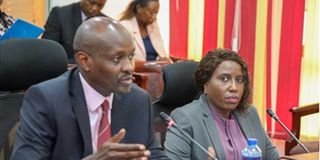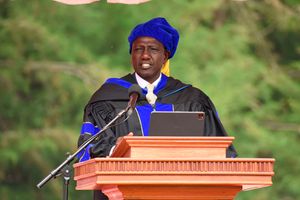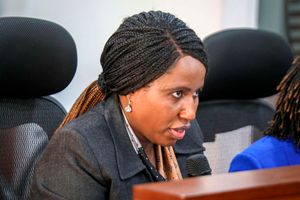
Higher Education Principal Secretary Beatrice Inyangala and Higher Education Loans Board CEO Geoffrey Monari before the Senate Education Committee on March 20, 2025.
University students who are funded through the new funding model are still not out of the woods despite the Court of Appeal suspending an earlier High Court judgment that declared the model unconstitutional.
The affected students are in their first and second year of study and those set to join universities in August and September this year.
“What has happened is that the Court of Appeal has just suspended the High Court orders but the appeal is still on,” insisted Dr Constantine Wasonga, the secretary-general of the Universities Academic Staff Union.
The court order left it open that the funding of the students could change after the full hearing and determination of the case.
“In their implementation of the new funding model (also known as Variable Scholarship Loan Funding Model) during the pendency of the appeal, the Higher Educations Loans Board (Helb) and the Trustees of the Universities Fund (UF), Kenya shall publicise to all the students who apply for and receive funding that the receipt of funding is provided under the VSLFM, which is under court challenge; and that the funding model may change in the future depending on the outcome of the appeals before the court,” the order reads.
The order came during the week when the Kenya Universities and Colleges Central Placement Service (Kuccps) is expected to open the applications portal for students who qualified for university admission in the 2024 Kenya Certificate of Secondary Education examinations.
Reached by the Nation for comment on whether the court order had any implication on the application process, the CEO of Kuccps Dr Agnes Mercy Wahome simply replied “Not at all.”
Not display the cost
Last week she revealed that the applications portal will not display the cost of the academic programmes as has been the case over the last two years, in compliance with the High Court judgment.
Under the VSLFM, the cost of the academic programme (at market rates) would be displayed on the applications portal for students to see before applying. They would then apply for a scholarship from UF and then tuition and upkeep loans through Helb.
Students who apply for placement in private universities qualify for the tuition loan but not for upkeep, this is after the government stopped sponsoring students who study in private universities.
The government is also facing the challenge of funding university students as it requires at least Sh25.85 billion to fully finance the 246,391 students who qualified for admission last year.
According to government data, the Sh25.85 billion required will be distributed as scholarships (Sh20.8 billion) and student loans (Sh5.05 billion).
Higher Education Principal Secretary Beatrice Inyangala, while appearing before the Education committee, revealed that for the first cohort under the model, the funding gap is Sh12.3 billion, noting that many students who applied for support this year remain unfunded, resulting in a Sh4.9 billion shortfall.
Additionally, continuing students under the differentiated unit cost model face a deficit of Sh4.8 billion, especially those graduating, while another Sh1 billion is needed for continuing students. This adds up to an overall shortfall of Sh13.7 billion.
“This is very serious, if this money is not available, universities might actually close by the last quarter of this financial year. We are experiencing a lot of problems, strikes are becoming more frequent and students are dropping out—not because they lack ability, but because they lack financial support,” she said.
The PS further indicated that the same financial problem applies to scholarships, which have a deficit of Sh11.2 billion. The shortfall stems from the first-time applicants (2022 cohort).
“The 2022 cohort was partially funded, but for the current cohort, the funding requirement was Sh13.9 billion, with only Sh4.2 billion provided, leaving a deficit of Sh9.6 billion,” she said.
“The current allocation stands at Sh23 billion, which represents only 38.75 per cent of the required amount. If universities were to be funded at a 50 per cent level, an additional Sh6 billion would be needed to adequately support them,” she added.
On March 14, the government disbursed Sh1.56 billion to students and trainees for tuition and upkeep. According to Mr Ogamba, the funds are in addition to the Sh32.7 billion disbursed in the current financial year for upkeep and tuition loans.
The chair of the Kenya Universities Staff Union, Charles Mukhwana, raised concerns about the financial sustainability of universities under the VSLFM, given the academic calendar structure of the institutions and the government financial calendar.
“Look at our programmes. We run until April, then there is a long break until September. That hiatus, that lacuna means there's no money coming to universities. So how are you going to pay the workers when there’s no money?
Leave alone that most parents of university students are poor. The rich will take their children to private universities maybe and take them abroad,” he said.
Treated differently
He added: “For primary schools, teachers work and receive their salaries from the government through the Teachers Service Commission. The same applies to secondary school teachers, vocational institutions and colleges. Why is it that universities are now being treated differently?”
Mr Mukhwana criticised the model for placing the burden of university education costs on students and their parents, warning that it could destabilise public universities.
“When you have a funding model that dictates students or parents must pay fees for me as a lecturer to be paid, I have an issue with that,” he stated. “No country in the world does that unless it’s a private institution.”










